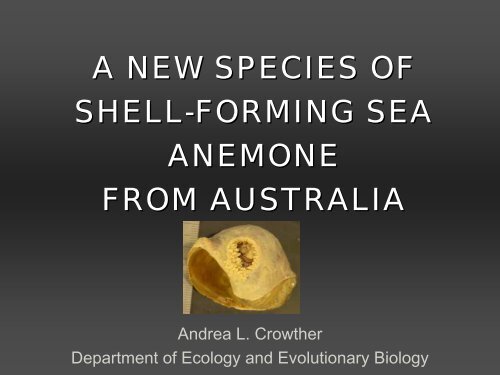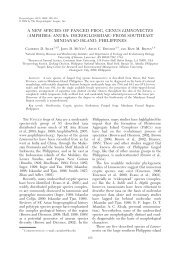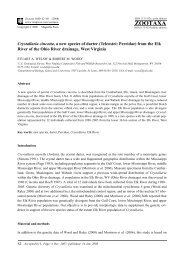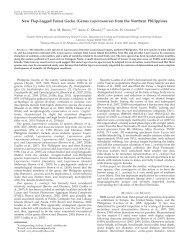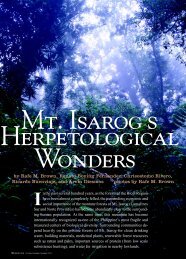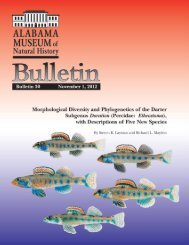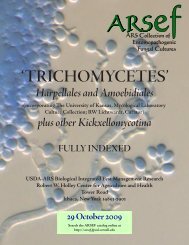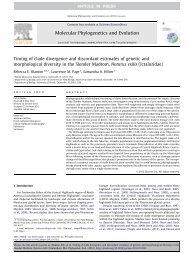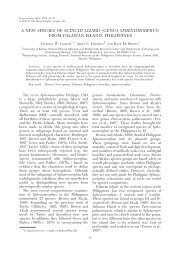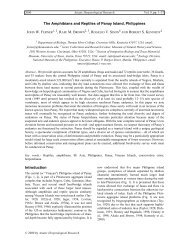a new species of shell-forming sea anemone from australia
a new species of shell-forming sea anemone from australia
a new species of shell-forming sea anemone from australia
Create successful ePaper yourself
Turn your PDF publications into a flip-book with our unique Google optimized e-Paper software.
A NEW SPECIES OF<br />
SHELL-FORMING SEA<br />
ANEMONE<br />
FROM AUSTRALIA<br />
Andrea L. Crowther<br />
Department <strong>of</strong> Ecology and Evolutionary Biology
Overview<br />
• Associations between hermit crabs and<br />
<strong>anemone</strong>s occur in nature<br />
• Hermit crab and Stylobates<br />
• Described <strong>species</strong> <strong>of</strong> Stylobates<br />
• New <strong>species</strong> found <strong>from</strong> Australia
Hermit crab and <strong>anemone</strong>s<br />
• Hermit crabs live in<br />
abandoned snail <strong>shell</strong>s<br />
• Anemones attach to <strong>shell</strong><br />
• Crabs change <strong>shell</strong>s as<br />
grow, sometimes transfer<br />
<strong>anemone</strong>s<br />
• From shallow tropical<br />
areas to deep <strong>sea</strong><br />
• General dynamics <strong>of</strong><br />
relationships<br />
http://www.divegallery.com/hermit_crab2.htm
Stylobates<br />
• Deep <strong>sea</strong> (300-1000 m)<br />
• Always host to hermit<br />
crab<br />
• Obligate symbiosis for<br />
<strong>anemone</strong><br />
• Shell-<strong>forming</strong>!<br />
• One <strong>anemone</strong> per crab
Benefits for the symbionts<br />
• For the crab<br />
– Protection<br />
• For the <strong>anemone</strong><br />
– Transport<br />
– Food availability<br />
– Shell to live in<br />
– Long term<br />
accommodation
The <strong>shell</strong><br />
• Carcinoecium<br />
• Chitinous secretion<br />
• Anemone coats and<br />
extends hermit crab’s<br />
<strong>shell</strong><br />
• Mistaken for a snail’s<br />
<strong>shell</strong><br />
http://s190418054.onlinehome.us/portal/20<br />
03/0312mon.pdf
Co-evolution<br />
www.es.ucl.ac.uk/schools/Glossary/gastropod.jpg<br />
www.glaucus.org.uk/Hermit4.htm<br />
www.aqualandpetsplus.com.Bug.%20Hermit%20Crabs.htm
Stylobates aeneus<br />
• Original description <strong>of</strong><br />
<strong>shell</strong><br />
• Anemone discarded!<br />
• Location: Hawaii and<br />
Guam (Pacific Ocean)<br />
• 402-797 m deep
Stylobates distribution<br />
Stylobates aeneus; Stylobates cancrisocia; Stylobates loisetteae; Stylobates n.sp.
Stylobates cancrisocia<br />
• Location: East Africa<br />
(Indian Ocean)<br />
• 818 m deep<br />
• 3 specimens
Stylobates loisetteae<br />
• Location: west coast<br />
<strong>of</strong> Australia<br />
• 320-508 m deep<br />
• Wide oral disc<br />
• Oral disc position
A <strong>new</strong> <strong>species</strong><br />
• Location: north east<br />
Australia<br />
• 680-960 m deep<br />
• 10 specimens<br />
• Size ranging <strong>from</strong><br />
5-9 cm length<br />
• Study <strong>of</strong> morphology
Species comparisons<br />
S. aeneus<br />
S. cancrisocia<br />
S. loisetteae<br />
New <strong>species</strong><br />
Locality<br />
Hawaii/Guam<br />
E. Africa<br />
W. Australia<br />
E. Australia<br />
Marginal<br />
sphincter<br />
muscle<br />
Endodermal,<br />
circumscribed,<br />
pinnate<br />
Endodermal,<br />
circumscribed,<br />
pinnate<br />
Endodermal,<br />
circumscribed,<br />
pinnate<br />
Endodermal,<br />
circumscribed,<br />
palmate<br />
Orientation<br />
on <strong>shell</strong><br />
Mouth behind<br />
and below<br />
aperture <strong>of</strong><br />
<strong>shell</strong><br />
Mouth near<br />
aperture <strong>of</strong><br />
<strong>shell</strong><br />
Mouth facing<br />
away <strong>from</strong><br />
aperture <strong>of</strong><br />
<strong>shell</strong><br />
Mouth near<br />
aperture <strong>of</strong><br />
<strong>shell</strong>
Review<br />
• Stylobates <strong>anemone</strong>s are found in the deep <strong>sea</strong><br />
• Form associations with hermit crabs<br />
• Produce carcinoecium<br />
• New <strong>species</strong> found <strong>from</strong> north east coast <strong>of</strong><br />
Australia
Acknowledgments<br />
• Supervisors:<br />
– Dr. Daphne Fautin (KU)<br />
– Dr. Carden Wallace (MTQ, Australia)<br />
• Collectors:<br />
– Dr. Alistair Birtles (JCU, Australia)<br />
– The late Dr. Peter Arnold (MTQ, Australia)<br />
• Sigma Xi<br />
• Questions


